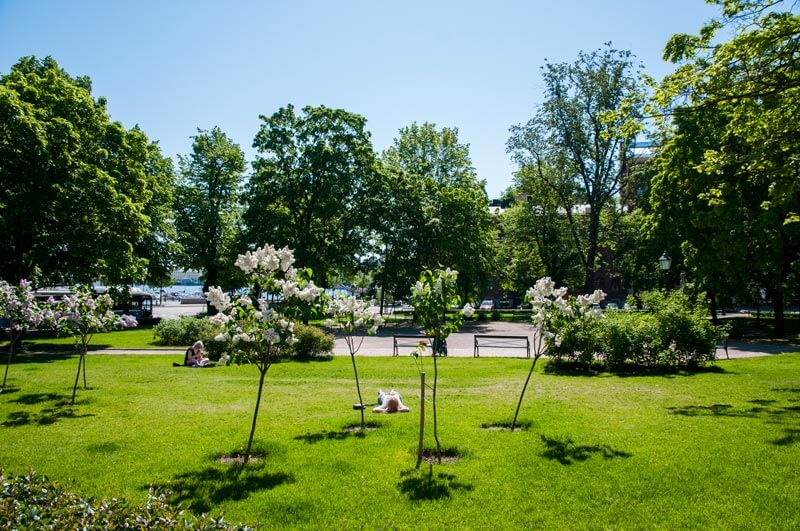This green is one of the oldest parks in Helsinki. The square with its flowers and plants has been an important area for local residents for over 180 years. A major renovation in 2008 restored the park to its former glory and is once again highly appreciated by the residents of Kruununhaka.
History
The common term used in the late 1800s for the city’s park and other green areas was “city plantings” (kaupunginistutukset in Finnish, stadsplanteringarna in Swedish). Small plantings were called “squares” (tori, torg). Accordingly, Liisanpuistikko was originally known as “Elisabetstorget”; Liisankatu street was formerly known as Elisabethsgatan and named after the wife of Tsar Alexander I (1777–1825). The park has been known as Liisanpuistikko since 1928.
In the plans drawn up by City Engineer C. E. Reuter in the 1870s, the green was a small scenic park in the shape of an oval covered by paths. The park was lined by trees and shrubs with shaped lawns in the middle. The tight network of paths allowed for long walks within a small area. The park benches were perfect for relaxing and watching the ships sail by. As the park was surrounded by the apartments of wealthy residents, it became a place for promenades and being seen among the well to do.
Svante Olsson, the city’s first official gardener who created the park culture in Helsinki, apparently drew up renovation plans for the green at the same time as he redesigned the green outside the House of Nobility. The general oval shape was retained, but some of the round and heart-shaped lawns were removed. A trimmed hedge was planted along the low fence, and some of the older trees were replaced by new ones. In the early 1900s a swing and sandbox were added for children.
The growing number of cars and the traffic arrangements that this entailed apparently led to City Plan Architect Birger Brunila’s decision to introduce rectangular borders in 1932, although the oval shape remained inside the park.
The biggest changes to the park were made in the early 1970s by Harald Carstens, head of the planning department for the city’s parks division. The playground became the dominant element in the park, and the historical shape of the park was sacrificed for a more rational park design in keeping with the times.
Renovation
Näkymä Landscape Architects is a local company that is specialised in the restoration of old parks. On the basis of a historical survey, the company drew up renovation plans for the green. The plans were approved in 2006, and the park was reopened in spring 2009 with an event organised by local residents. The oval shape returned inside the park, and overall the park received a much needed makeover without forgetting the needs of children. The surrounding streets were also renovated at the same time, creating a stylish environment.
Local residents were very active in commenting about the plans throughout the process. The nearby island of Tervasaari has excellent play areas for children, as well as a dog park, so it was allowed to restore the historic shape of “Liisa Green” as designed by Svante Olsson. Today the look of the park is once again consistent with the surrounding buildings from the late 1800s and early 1900s.
The new park furniture, fences, litter bins, benches and lighting were also designed to be historically suitable. A swing and spring riders were installed for children. A recycling point is located next to the street, and there is also a tidy public toilet.
The most valuable elements in the green are its large old trees. Special care was taken to preserve them. Species include lindens and maples, as well as two fine elms. One of the elms measuring 340 cm in circumference at chest height and a linden measuring 450 cm in circumference are among the biggest in Helsinki. The trees have been studied and are being cared for and monitored.




The range of other plants in the park was augmented with traditional species. The fence is lined by a pruned cotoneaster hedge. Lilac, mock orange and rose bushes have been planted in well-defined groups. Cherry trees along the shore side of the park bid visitors a warm welcome to the park. The Battle of Pellinki Memorial was moved to a more prominent position and surrounded by summer flowers.
The green now has the distinguished and peaceful atmosphere of an old park. It serves as a soothing oasis amidst the massive stone buildings in the Kruununhaka district. The large trees act as a barrier against the busy traffic along the shoreline.
The historic “canopy kiosk” (lippakioski in Finnish) is an icon of Functionalist architecture and serves coffee and ice cream. Visitors can also relax on the terrace outside Svenska Klubben. The club’s terrace was the result of a design competition held among architecture students in the early 1990s. The competition was won by Johanna Roppe with her wooden cube, which opens into a pretty terrace kiosk on sunny days. The sand playing field in the park is ideal for playing petanque, while the lawns are perfect for picnics.


